Composite membrane with electrospun multiscale-textured surface for robust oil-fouling resistance in membrane distillation
Authors and their institutions:
Deyin Hou, Zhangxin Wang, Kunpeng Wanga, Jun Wang, Shihong Linc
Key Laboratory of Drinking Water Science and Technology, Research Center for Eco-Environmental Sciences, Chinese Academy of Sciences, Beijing 100085, PR China
State Key Laboratory of Environmental Aquatic Chemistry, Research Center for Eco-Environmental Sciences, Chinese Academy of Sciences, Beijing 100085, PR China
Department of Civil and Environmental Engineering, Vanderbilt University, Nashville, TN 37235-1831, United States
Periodical:
Journal of Membrane Science
Impact Factor :
5.557
Abstract:
In this study, we developed composite membranes with a hydrophobic substrate and a hydrophilic top surface using electrospinning to mitigate oil fouling in membrane distillation (MD). The electrospinning approach can be universally applied to any hydrophobic membrane substrate and to ensure the non-wetting condition of the substrate due to the electrospun fibrous structure. Using this approach, polytetrafluoroethylene (PTFE) hydrophobic substrate was coated with two different hydrophilic fibrous networks, including a cellulose acetate (CA) fibrous network and a nanocomposite fibrous network comprising CA and silica nanoparticles (SiNPs). We characterized the pristine and the modified membranes using contact angle measurements and tensiometer-based oil probe force spectroscopy, and tested the anti-fouling performance of the different membranes in MD experiments using a saline crude-oil emulsion as the feed solution. While both coatings offered significant improvement in oil fouling resistance compared to the substrate PTFE membrane, the nanocomposite CA-SiNPs fibrous coating outperformed the CA coating in terms of hydrophilicity, oil adhesion resistance, and anti-oil-fouling performance in MD experiments.
Results and discussion:
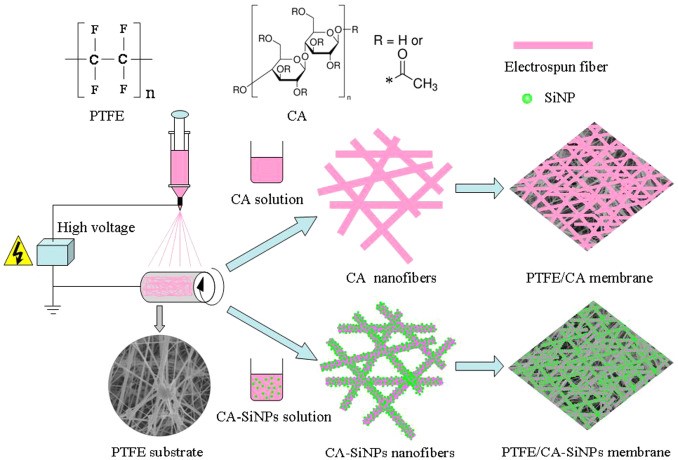
Fig. 1. Schematic illustration of the procedure for fabricating the composite membranes with electrospun CA or CA-SiNPs fibrous network.

Fig. 2. SEM images of the surfaces of (A-1) and (A-2) the commercial PTFE membrane, (B-1) and (B-2) the PTFE/CA composite membrane, (C-1) and (C-2) the PTFE/CA-SiNPs composite membrane.
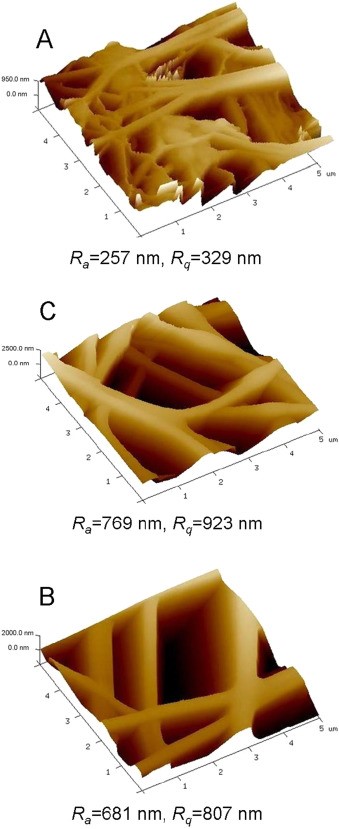
Fig. 3. AFM images of the surfaces of (A) the commercial PTFE membrane, (B) the PTFE/CA composite membrane, (C) the PTFE/CA-SiNPs composite membrane.
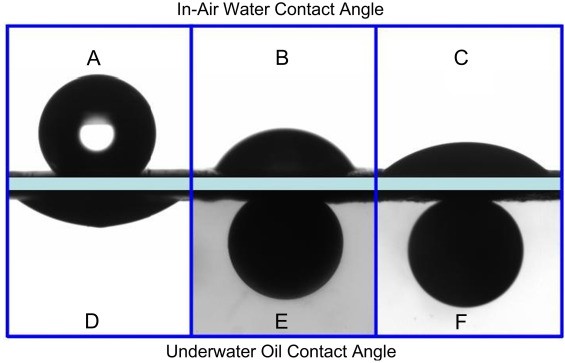
Fig. 4. In-air water contact angle of (A) the commercial PTFE membrane, (B) the PTFE/CA composite membrane, and (C) the PTFE/CA-SiNPs composite membrane. Underwater oil contact angle of (D) the commercial PTFE membrane, (E) the PTFE/CA composite membrane, and (F) the PTFE/CA-SiNPs composite membrane.
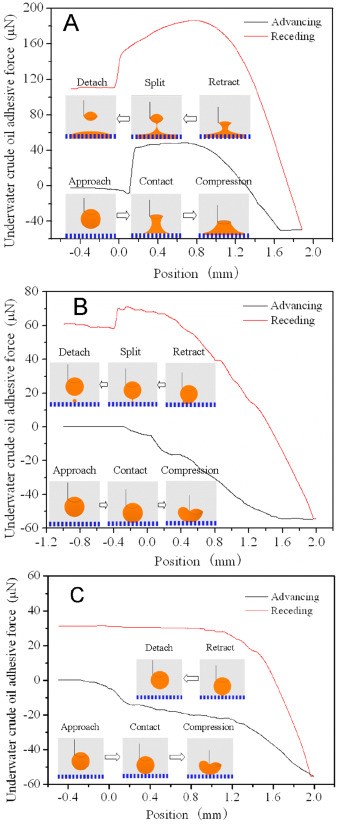
Fig. 5. Force-position curves recorded for the underwater interaction between the oil droplet and the membrane surface for (A) the commercial PTFE membrane, (B) the PTFE/CA composite membrane, and (C) the PTFE/CA-SiNPs composite membrane. The x axis represents the relative position of the membrane, with position zero corresponding to the first contact between the oil droplet and the membrane.
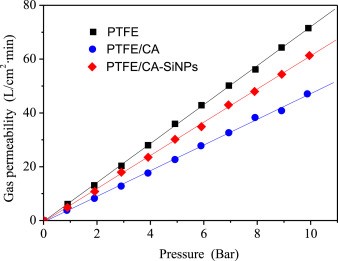
Fig. 6. Nitrogen gas permeate flux of (A) the commercial PTFE membrane, (B) the PTFE/CA composite membrane, and (C) the PTFE/CA-SiNPs composite membrane.

Fig. 7. Permeate fluxes from DCMD tests of (A) the commercial PTFE membrane, (B) the PTFE/CA composite membrane, and (C) the PTFE/CA-SiNPs composite membrane. The salt solution with 600 mM NaCl was used as the feed. The flow rate of feed and permeate streams were both 70 L/h. The feed and distillate temperatures were 53 °C and 20 °C, respectively.
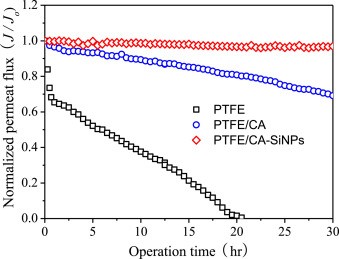
Fig. 8. Normalized permeate flux for the commercial PTFE membrane and the fabricated composite membranes in the DCMD experiments. The saline oil-in-water emulsion with 600 mM NaCl and 1000 mg/L crude oil was used as the feed. The flow rate at feed and permeate side were 70 L/h. The feed and distillate temperatures were 53 °C and 20 °C, respectively. The initial permeate fluxes for PTFE membrane, PTFE/CA and PTFE/CA-SiNPs composite membranes were 19.56 L/m2 h, 17.36 L/m2 h and 19.92 L/m2 h, respectively.
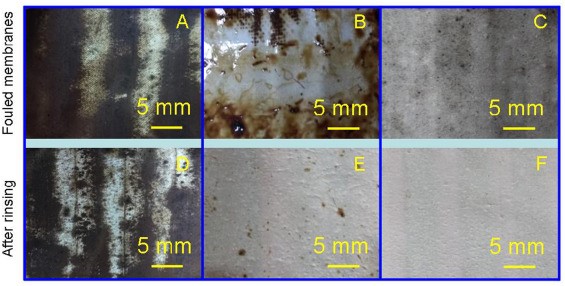
Fig. 9. The photographic images of the membranes after DCMD experiments, and the photographic images of the fouled membranes after rinsing 2 min with DI water (A) and (D) the commercial PTFE membranes, (B) and (E) the PTFE/CA composite membranes, (C) and (F) the PTFE/CA-SiNPs composite membrane.
Conclusions:
Novel composite membranes with asymmetric wettability have been developed in this study to mitigate oil fouling in MD processes. These membranes are composed of a PTFE substrate and an electrospun, in-air hydrophilic and underwater oleophobic top surface. Such a coating layer significantly changed the wetting property of the substrate PTFE membrane, rendered it drastically less attractive to oil droplets, and consequently enhanced the membrane resistance against oil fouling. Of the two types of surface coating we developed, we found that the CA-SiNPs coating was more effective than the CA coating in imparting the oil fouling resistance as the SiNPs augmented the in-air hydrophilicity and underwater oleophobicity of the coating layer. While a PTFE membrane was severely fouled in DCMD experiments with a feed stream containing 1000 mg/L crude oil as foulant, the PTFE/CA-SiNPs membrane was able to sustain a stable operation over 30 h. The findings in this study provide important insights to the development of anti-fouling membranes for MD, which may potentially enable MD to desalinate more challenging saline wastewater with a strong fouling potential.
Statement:
1. Network disk download: https://pan.baidu.com/s/14cM0sXgx4vge9vZZMQHk0w
2. This article is only for academic exchanges, and is welcomed by the majority of scholars to share and reproduce. If there is any infringement of the article content, please contact us for modification.

